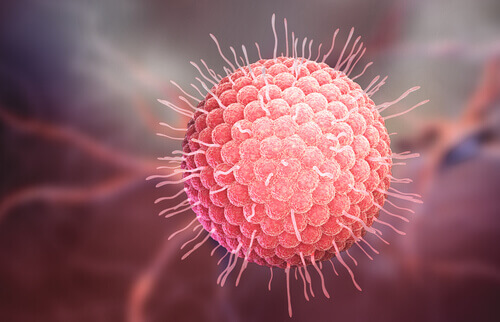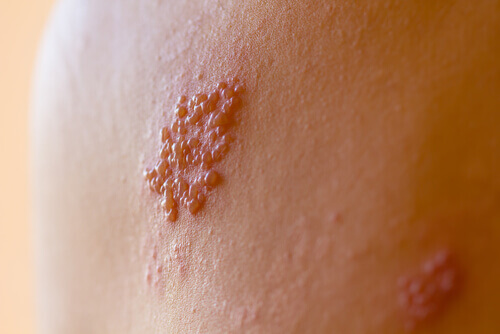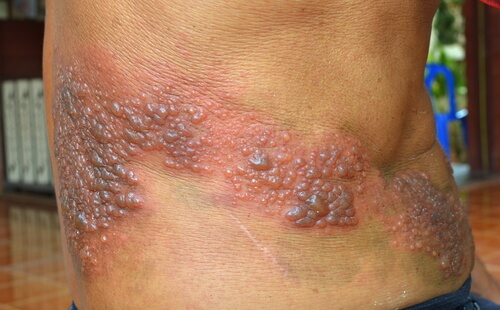Shingles Symptoms and Diagnosis Facts to Know


Reviewed and approved by the doctor José Gerardo Rosciano Paganelli
Shingles (also known as herpes zoster) is an infection caused by the VZV virus or varicella-zoster virus. This disease mainly affects the nerves underneath the skin.
The principal shingles symptoms include:
- Inflammation
- The appearance of blister-like eruptions
These eruptions appear along the affected nerve. Therefore, they are easily visible.
The affected skin appears irritated, with small blisters that follow the path of a nerve. For this reason, people commonly call the illness “shingles.” The blisters produce pain that seems to burn the dermis. So, in some places in the world, people call it “Saint Anthony’s Fire.”
In the majority of cases, this illness affects older adults. However, a great many adolescents have suffered shingles episodes, although these are normally mild cases. The disease usually causes greater complications in older adults.
Causes of shingles

The virus that causes shingles is the same as the one that causes varicella (chickenpox). This virus is never eradicated from the body. Instead, it remains in an organism in a latent state. Under certain health conditions, the virus reactivates in the nerve nodes.
Not everyone who has had varicella (chickenpox) will develop shingles. Normally, the virus reactivates in those who have temporary or permanent alterations to their immune systems, caused by age, another illness, or the use of medications. Such medications include corticoids, rheumatism medication, and others.
Shingles is not contagious. However, a person suffering from this illness can pass the varicella virus to someone who has never had chickenpox. The virus can only be transferred through direct contact with the blisters.
Adults over 50 years of age are more likely to develop this disease. Those suffering a compromised immune system due to HIV are also susceptible. Likewise, those who suffered from varicella (before their first birthday) can also develop shingles.
Check out this article: 7 Problems You Experience When You Have a Compromised Immune System
Shingles symptoms

The first shingles symptoms are:
- Itching
- Tickling sensation
- Tingling
- Focal pain
Furthermore, during the initial phase of shingles, the following shingles symptoms can also occur:
- Fever
- Headache or general discomfort
- Gastrointestinal discomfort
Without a doubt, the main symptom of shingles is the presence of blisters. In the beginning, the eruptions are small, but they can grow and merge with other blisters, forming large sores. Normally, the growth period for these sores ranges from 3 to 5 days. Later, scabs form, corresponding to the final phase of the illness.
In cases in which the virus reappears on the head, it can affect one’s sight or hearing. If it affects the mandibular nerve, lesions can form in the oral cavity, on the tongue, or in the throat. On rare occasions, a person can lose their sense of taste.
Diagnosis and complications

Shingles is diagnosed following a physical exam of the patient, taking into account his clinical history and records.
If there is any uncertainty about whether the correct diagnostic is indeed shingles, a sample of skin cells from the lesions can be taken for a lab test, which will allow the case to be further evaluated. A blood test is another viable method to establish a definitive diagnostic.
Lumbar puncture may be performed to diagnose the illness, but only when the nervous system is compromised. Additionally, in atypical cases, it may be necessary to undergo a Tzanck smear, which involves scraping and testing the liquid contained in the blisters.
Want to know more? See: How to Treat Shingles Naturally
One of the most frequent, severe complications of this illness is postherpetic neuralgia. This occurs in 50% of patients and consists of pain that many describe as burning, electric, and unbearable.
In the most severe cases, the pain can completely incapacitate an individual. The worst part is that this pain can persist for weeks, months, years, or even for a lifetime.
Other complications may involve vision problems, when herpes zoster occurs near the eye. In many cases, the effects can be severe. Additional infections can occur on the skin, such as cellulite or impetigo. In some cases, this type of herpes produces meningitis.
All cited sources were thoroughly reviewed by our team to ensure their quality, reliability, currency, and validity. The bibliography of this article was considered reliable and of academic or scientific accuracy.
- Schmader, K. (2016). Herpes Zoster. Clinics in Geriatric Medicine. https://doi.org/10.1016/j.cger.2016.02.011
- Nagel, M. A., Cohrs, R. J., & Gilden, D. (2013). Varicella zoster virus infections. In Viral Infections of the Human Nervous System. https://doi.org/10.1007/978-3-0348-0425-7_5
- Dworkin, R. H., Johnson, R. W., Breuer, J., Gnann, J. W., Levin, M. J., Backonja, M., … Whitley, R. J. (2007). Recommendations for the Management of Herpes Zoster. Clinical Infectious Diseases. https://doi.org/10.1086/510206
This text is provided for informational purposes only and does not replace consultation with a professional. If in doubt, consult your specialist.








